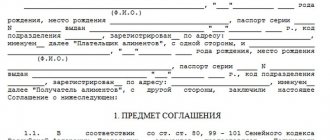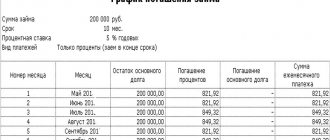When parents divorce and most often the child remains to live with his mother, not every father continues to support and raise him. This responsibility falls on the shoulders of the parent with whom the child lives after the divorce, although according to the law (Article 80 of the RF IC), responsibility for maintaining a minor dependent should be distributed equally between the mother and father. When an unscrupulous father ignores the requests of his ex-wife in favor of financial support for the child, she has to go to court to force the collection of alimony.
It seems that the problem has been resolved, however, even after a court decision on alimony payments was made, the father continues to evade parental obligations or does so irregularly. And according to the legislative framework, such acts are subject to administrative liability in the form of a fine and payment of a penalty. However, not every mother knows how to calculate the penalty for alimony and what to do if a large amount of debt arises.
What is a penalty for alimony?
A penalty for alimony is a type of fine imposed if the alimony payer dishonestly fulfills his obligations to timely pay financial assistance to the child in accordance with a court writ of execution or a notarial agreement. In other words, a penalty is a penalty that is charged for each day the debt is formed (0.5% per day). That is, the larger the amount of debt, the higher the amount of the penalty will be; accordingly, if it is not repaid on time, the alimony debt will grow much faster.
The accrual of a penalty of 0.5% for each subsequent day for non-payment of alimony is determined by Article 175 of the Family Code.
Calculator for calculating the penalty for alimony at the moment
For example, if a debtor pays 20,000 rubles a month and does not pay alimony for 40 days, then the amount of the penalty will be calculated as follows: 20,000 * 0.005 * 40 = 4,000 rubles. In this case, the amount of debt will be about 26,000 rubles. In total, you will have to pay approximately 30,000 rubles. This calculator was made in accordance with the rules and regulations of Article 115 of the RF IC and allows you to calculate the amount of the penalty (penalty) for alimony. For ease of use, the ability to select the period during which the debt arose has also been added.
The payer's salary was delayed or the salary was not paid at all in the current period. The payment was not made due to the fault of the accounting department of the Employer or a banking organization. The payment was overdue due to the payer's illness and lack of income for this reason. Timely payment was prevented by extraordinary circumstances. Catastrophes, natural disasters, and other force majeure circumstances. The writ of execution is with the recipient and is not provided to the payer’s employer
We recommend reading: Donation agreement and personal income tax
Online calculator for calculating alimony penalties
Enter debt parameters
| Insert debt data | Data import instructions 1. Copy the data from the editor (as in the picture). Pay attention to the order of the columns : date, amount 2. Paste the data into the field on the left 3. Click "Insert" |
| Insert payment details | Data import instructions 1. Copy the data from the editor (as in the picture). Pay attention to the order of the columns : date, amount 2. Paste the data into the field on the left 3. Click "Insert" |
Calculation result:
Permanent link to the calculation results: Copy link
| Debt: | rub. | Beginning of period: |
| Percent: | End of period: |
Copy table | Print table | Copy link
Can't collect child support? We will help!
The principle of operation of the calculator is to automatically calculate the debt according to the monthly amount of alimony and the number of days of delay in payment. Based on the entered data, the calculator multiplies the number of days of delay by the established penalty (by default), determined by the norms of the Family Code. It is very important to enter the required information correctly here.
How to calculate a penalty using a calculator
Before you start making online calculations, you should understand that the calculator cannot calculate the entire amount of debt, for example, for six months. It makes calculations for each individual month. Before you begin, please read the basic rules for entering data:
- Enter the date when the debt began to form, that is, the day when the father did not transfer the monthly amount of alimony according to the writ of execution.
- Next, enter the amount of alimony you should have received for this month.
- In the “Percentage” field, enter the established penalty. If alimony is paid by court decision, then by default leave 0.5%, and if you determined the amount of the penalty yourself when signing a notarial agreement on alimony, then enter a different figure.
- Be sure to indicate the end date, that is, for how many days to calculate the penalty.
- Also, the calculator can independently calculate the difference, subject to conditions, if part of the debt was paid during a given period.
The calculator works on the basis of the established rules for calculating penalties given in Article 115, Part 2 of the Family Code.
The only disadvantage of this method of calculation is that using a calculator you have to determine the debt for each specific month separately, because the amount of alimony depends on the father’s earnings. That is, in order to find out the total amount of the debt, for example, if the alimony payer has already been in debt for more than 4 or 5 months, then it is necessary to calculate each individual period, and then add up the resulting values. This will be the total amount of debt over a long period.
How to calculate the penalty for alimony
In accordance with Art. 115 of the RF IC, the amount of the penalty is defined as 0.1% of the total amount of debt for each day of failure to fulfill the obligations imposed by law. What is noteworthy is that this percentage until 2021 was 0.5%. Such a significant reduction in the amount of collection is due to conclusions from current practice - often the accrued amounts of fines turned out to be unaffordable for debtors to pay.
In order to receive the funds due from the defaulter, the recipient must send an application to the magistrate's court for the collection of alimony penalties. In this case, you will have to carry out the calculations yourself - a special formula is provided for this.
Formula for determining the amount of alimony penalty
To successfully recover, it is important for the recipient of financial support to submit to the court a table that sets out the monthly calculation of the penalty for each day. The amount of alimony debt is clarified by the bailiff taking into account the previously established amount of alimony and is reflected in the resolution on debt calculation
In accordance with the information presented, the plaintiff will have to calculate the penalty for alimony using the following formula:
Nm = SBP * KDM * 0.001, where:
- Nm – the amount of the penalty for one month;
- SAD – the amount of alimony debt for one month;
- KDM is the number of days in one month.
Important: when calculating, the amount of debt for each month of default is added up. As a result: debt increases with each reporting period, which directly affects the penalty amounts
To simplify calculations, a calculator for alimony penalties is provided, with which you can obtain more reliable information by entering the necessary information in the appropriate fields.
Grounds for receiving a penalty
Before you start calculating the penalty, first familiarize yourself with when you can demand repayment of not only the debt, but also the penalty.
In what cases is a penalty collected?
Below is a list of grounds that must be met in order to legally demand payment of debts and penalties:
- the collection of alimony has legal force, that is, this decision is recorded in a judicial writ of execution or in a voluntary agreement between parents certified by a notary;
- the court granted the mother’s application for calculation and penalty;
- if a debt has arisen, then the document on the collection of alimony and penalties must be handed over to the bailiff. And he, in turn, applies coercive measures to the debtor to pay off the total debt;
- the debt arose due to the payer’s fault without good reason.
In what cases is the penalty not collected?
Now we need to consider situations when the court may reject your request to accrue a penalty for alimony:
- the debt arose for good reasons, for example, the alimony payer was fired from work or temporarily lost his ability to work;
- when the non-transfer of funds was not due to his fault, for example, the company’s accounting department did not make the necessary deductions from the alimony payer’s salary or the payment was frozen due to negligence or operational errors of the banking system;
- the writ of execution for the collection of alimony was not transferred to the bailiff service;
- when it was not possible to pay alimony as a result of circumstances beyond the payer’s control, for example, an emergency, natural disasters, etc.
As for the lack of timely alimony payments due to the fault of the alimony payer, if their delay has valid grounds, he needs to confirm this. Typically, confirmation is a certificate from work, a bank or a medical institution.
Amount of penalty for alimony
Regardless of how alimony is collected - through the court or voluntarily, the penalty begins to accrue from the first day of the next month, if the amount has not been transferred earlier.
Amount of penalty under the contract
The agreement implies the conclusion of a voluntary agreement on the payment of alimony, which is certified by a notary to give it legal force. This agreement specifies:
- amount of alimony;
- collection procedure;
- methods of obtaining;
- duration of the agreements;
- payment form;
- liability of the parties, including the accrual of penalties.
When concluding a notarial agreement, the amount of the fine is set at the discretion of both parties and can be more than 0.5%. To collect it, you must go to court with a signed agreement.
Amount of penalty according to law
By law, the amount of the penalty is fixed in the Family Code: Article 115. As we have already said, the penalty is equal to 0.5% for each overdue day of the total debt. Bailiffs are forced to pay the penalty based on a court decision. Penalties accrue until the debt is repaid in full. In addition, if the debt has accumulated over several years, then the statute of limitations for such cases is 3 years and you can file a lawsuit to collect the debt even after the child turns 18 years old.
Calculation of the amount of penalty for alimony in 2021
Dear readers! The article talks about typical ways to resolve legal issues, but each case is individual. If you want to find out how to solve your particular problem , contact a consultant:
- Contact the bailiff who is conducting enforcement proceedings on alimony with an application for issuing a resolution to calculate the debt or use a voluntary agreement to calculate it.
- Prepare a calculation of penalties according to law or contract.
- Prepare the necessary package of documents (passport, writ of execution or court order, calculation of penalties).
- File a claim in the magistrate's court at your place of residence or the place of residence of the defendant.
- Wait to be called to a court hearing.
12 Jun 2021 uristlaw 262
Share this post
- Related Posts
- Cadastral Cost of Apartment By Address Free 2020
- Cash Compensation for Veterans of the Armed Forces in the Moscow Region
- How to Build a House with Maternal Capital on St.
- Where to evade whether one of the participants refused privatization
Who calculates alimony penalties?
Just like that, according to your decision, as well as the calculations made, you cannot force the debtor to pay the penalty. This is done by the bailiff service, but only after a court decision has been made. If the court has granted the request for a penalty, the bailiff makes a calculation, and then takes enforcement measures to collect the debt from the alimony payer. To do this, the bailiff has information about the debtor’s place of work, as well as whether he has property.
When making a decision on forced collection of both debt and penalties, the court can rely only on the information of the bailiff, but not on the plaintiff’s independent calculations.
You can learn how to calculate the penalty using formulas established by law, just at least for the purpose of understanding how it works in practice, and also so as not to contact the bailiffs once again if you want to know the approximate amount for the past period, especially if the payer regularly violates deadlines .
Formulas for calculating alimony penalties
Now let's move directly to the calculations. To do this, you need to use one of the formulas. Remember that if the father partially contributed small amounts of alimony debt, then they will need to be subtracted from the resulting figure at the end. If the debt has accumulated over several months, then it is better to sometimes come to the bailiff service and compare their data with yours so that there are no discrepancies.
Formula for calculating penalties for a month
Total amount of debt * number of days in a month * % of the penalty.
Formula for calculating penalties for a specific period
Amount of debt for a certain month * number of overdue days * % of the penalty.
Calculator for Calculating Penalty for Alimony 2021
Of course, I’m not a girl, but I can help. You don’t have to indicate anything in the notes. Additional debts are additional alimony debts that usually arise monthly. And the “More debt” button will just help you fill out your monthly alimony payments.
Hello, dear girls, who has used this calculator, please tell me what needs to be indicated in the notes in the “Partial payment of debt” column? I also don’t understand what needs to be filled in in the “additional debts” and “Additional debt” columns. Court on February 27, previous calculations were made by a lawyer, I paid money - in court they said everything was wrong. I’m tired of talking to lawyers who charge for their services, but the result is deplorable. Thanks in advance.
This is interesting: Benefits for a young family without children
Examples of calculating penalties for alimony
For a better understanding, it is better to consider the presented formulas using an example.
Example 1
The father stopped paying child support in March. Today is the month of June. Alimony payments were established by the court in a fixed form in the amount of 6,000 rubles. So, the calculation of the penalty will be as follows:
- March = 6000*31 days*0.5% = 930 rubles.
- April = (6000+6000)*30 days*0.5% = 1800 rubles.
- May = (6000+6000+6000)*31 days*0.5% = 2790 rubles.
Total: 930+1800+2790=5520 rubles - penalty for 3 months, or 23,520 rubles - total debt with penalties.
Example 2
Child support is paid in proportion to the father's salary. Based on the income of the child support payer, the child should have received 10,000 rubles in January, 9,200 rubles in February, and 9,800 rubles in March. However, the established amounts never arrived. In this case, the calculations will be as follows:
- January: 10000*31days*0.5% = 1550 rubles.
- February: (10000+9200)*28 days*0.5% = 2688 rubles.
- March: (10000+9200+9800)*31day*0.5% = 4495 rubles.
Total: the penalty for the entire period of delay is 8,733 rubles, and the total debt with penalties is 37,733 rubles.
If you are going to file a lawsuit to force collection of debt, then before providing the data from the online calculator, it is better to check the received data with the bailiff’s certificate, and then attach the document to the statement of claim. Remember that the alimony payer can be held accountable for late payment of alimony only if he has no good reason for doing so. In such a difficult matter, it is best to seek the help of an experienced lawyer.
Penalty for non-payment of alimony
- Assignment of alimony as a percentage of salary. For one child 25% is paid, for two – 33%, for three or more – 50%. If the payer is not employed, money will be withheld from unemployment benefits or pensions. In the absence of any types of official income, payments are assigned in a fixed amount of money.
- Alimony in a fixed amount. Their appointment is made if the alimony-obligated person receives a salary in foreign currency or it is impossible to determine his average earnings. The size is determined taking into account the financial and property status of the parties. The cost of living established in the region for a child is also important.
Until July 29, 2021, the amount of the penalty was 0.5% of the total debt. This resulted in the formation of huge debts for the payers, and in some cases their size reached several million, and the penalty itself was 182.5% per annum.
This is interesting: Additional payments for Pensioners for travel How to apply








